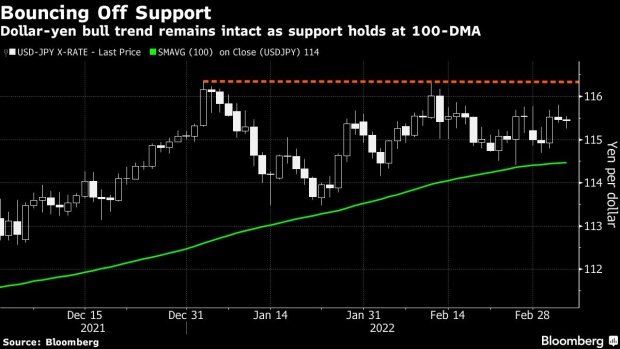Mar 6, 2022
Shock Commodities Spike Threatens to Push Yen to Six-Year Low
, Bloomberg News

(Bloomberg) -- The headwinds for yen are getting stronger and threaten to push the currency to a six-year low against the dollar.
A spike in global commodity prices spurred by Russia’s invasion of Ukraine is likely to worsen Japan’s trade deficit as the country is a net oil importer and may push the yen to 120 per dollar this year, according to Mitsubishi UFJ Morgan Stanley Securities. Mizuho Bank Ltd. and TD Securities both predict the currency will weaken to 117 by the end of June, from 114.82 on Friday.
Higher prices for commodities combined with widening U.S.-Japan rate spreads on expectations of higher U.S. interest rates while the Bank of Japan stays dovish are also weighing on the yen’s outlook.
“The biggest side-effect from the Ukraine situation is the rise in commodities, which deteriorates Japan’s terms of trade by expanding trade deficits,” said Daisaku Ueno, chief currency strategist at Mitsubishi UFJ Morgan Stanley in Tokyo. “On top of that, the U.S. looks set to raise rates this month, which widens rate differentials and leads to dollar buying as the BOJ isn’t expected to shift policy under such circumstances.”
The yen may weaken to 116 per dollar by mid-year and to 117 by the end of 2022, Ueno said, adding that the currency may decline to 118 to 120 this year. The pair’s option implied volatility is signaling a 51% probability the currency will reach 118 by end-June, with a 29% chance of it hitting 120.
The dollar-yen’s bull trend remains intact after it bounced off support at its 100-day moving average toward the end of February, A breach of resistance at 116.35, the Jan. 4 high, paves the way for the pair to push even higher.
The yen has declined about 2% in the past three months, the fourth-worst performance among its Group-of-10 peers, hurt by 2.2 trillion yen trade deficit in January, the highest in eight years. The shortfall may widen even further after crude oil surged past $110 a barrel last week.
Policy Divergence
Unlike the Federal Reserve, which is expected to start a rate-hike cycle this month, BOJ Governor Haruhiko Kuroda said Feb. 10 there’s “no chance” that monetary easing will be reduced.
Traders this week will look forward to a report which may show Japan’s current-account deficit widened to 871 billion yen in January from about 371 billion yen the previous month.
“As U.S. yields back up further and Japan maintains its highly accommodative policy stance, this suggests upside for dollar-yen, at least in the next few months,” says Mitul Kotecha, chief EM Asia and Europe strategist at TD Securities in Singapore.
Here are the key Asian economic data due this week:
- Monday, March 7: China trade balance
- Tuesday, March 8: Australia business confidence, New Zealand 4Q volume of all buildings, Japan labor cash earnings and BoP current-account balance, Taiwan trade balance and CPI
- Wednesday, March 9: RBA Gov. Lowe speaks, Australia consumer confidence, China CPI and PPI, New Zealand 4Q manufacturing activity, Japan 4Q GDP
- Thursday, March 10: New Zealand retail card spending, Japan PPI, Thailand consumer confidence
- Friday, March 11: RBA Gov. Lowe speaks, New Zealand manufacturing PMI, Japan household spending, South Korea BoP current-account balance, Philippine trade balance, Malaysia industrial production, India industrial production
©2022 Bloomberg L.P.


